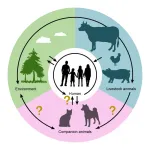(Press-News.org) University of Pittsburgh researchers have developed a universal receptor system that allows T cells to recognize any cell surface target, enabling highly customizable CAR T cell and other immunotherapies for treating cancer and other diseases. The discovery could extend into solid tumors and give more patients access to the game-changing results CAR T cell therapy has produced in certain blood cancers.
Described in a Nature Communications study published today, the new approach involves engineering T cells with receptors bearing a universal “SNAPtag" that fuses with antibodies targeting different proteins. By tweaking the type or dose of these antibodies, treatments could be tailored for optimal immune responses.
The researchers showed that their SNAP approach works in two important receptors: CAR receptors, a synthetic T cell receptor that coordinates a suite of immune responses, and SynNotch, a synthetic receptor that can be programmed to activate just about any gene. With the addition of SNAP, the possibilities for customized therapies become almost endless.
“We showed for the first time that we can make a universal SynNotch receptor. This SNAP-SynNotch system is super programmable because you can have both designer input and designer gene output,” said senior author Jason Lohmueller, Ph.D., assistant professor of surgery and immunology in the division of surgical oncology at the Pitt School of Medicine and investigator at UPMC Hillman Cancer Center. “Our hope is that we can use this approach to make cell therapies and deliver genes for cancer, autoimmune disorders, organ transplantation tolerance and more.”
CAR T cell immunotherapy involves engineering a patient’s own cells so that the T cell receptor recognizes a specific protein on cancer cells before infusing them back into the patient.
“One of the big problems with CAR T therapy is that you’re targeting just one protein,” explained Lohmueller. “If the tumor evolves to lose that protein or downregulate it, you need to re-engineer the T cells a second time, which is a highly involved and expensive process.”
To overcome this problem, Lohmueller, first author Elisa Ruffo, Ph.D., postdoctoral associate at Pitt, Alexander Deiters, Ph.D., professor of chemistry at Pitt and their colleagues developed universal SNAP-CAR T cells by adding a SNAPtag enzyme to the CAR receptor. These cells are administered along with cancer-targeting antibodies that are labeled with a molecule called benzylguanine.
Via a bio-orthogonal chemistry — a type of reaction that occurs in living systems without interfering with natural processes — the SNAPtag reacts with benzylguanine, fusing the antibody to the receptor. Adding different antibodies, at the same time or one after another, allows the receptor to recognize different tumor features.
“What’s unique about our approach is how the T cell interacts with the antibody. It’s not just binding, but fusing via covalent attachment — the strongest form of chemical bond,” explained Lohmueller. “This type of bio-orthogonal approach has been shown to work in animals for imaging purposes, but we’re among the first to use it therapeutically, so we’re really pushing the boundaries of covalent technology.”
An advantage of this tight bond means that activation of the receptor can be achieved with lower doses of antibody, said Lohmueller. Using mathematical modeling, graduate student Adam Butchy and Natasa Miskov-Zivanov, Ph.D., assistant professor of electrical and computer engineering at Pitt’s Swanson School of Engineering, showed that it may also be possible to get activity from weaker interactions between antibodies and tumor cells, giving greater flexibility to the types of cancer proteins that can be targeted.
The covalent bond was also the secret ingredient for creating SNAP-SynNotch cells. When a SynNotch receptor is activated, mechanical pulling forces stretch the receptor to expose part of the protein, which is then cut to release a transcription factor that travels to the cell’s nucleus to turn on expression of a chosen gene.
“We found that we needed the strength of a covalent bond to tolerate that pulling force,” explained Lohmueller. “If we just had binding between receptor and antibody, the receptor would come apart and we wouldn’t get signaling.”
The researchers showed that their universal SNAP-CAR and SNAP-SynNotch receptors could be activated in response to different targets by adding the corresponding antibodies. SNAP-CAR T cells were also able to simultaneously target multiple proteins on different types of cells, suggesting that they could help avoid cancer relapse due to variation in tumor targets or loss of those targets.
In a mouse model of cancer, treatment with SNAP-CAR T cells shrunk tumors and greatly prolonged survival, an important proof-of-concept that sets the stage to test this approach in clinical trials in partnership with Coeptis Therapeutics, which has licensed the SNAP-CAR technology from Pitt.
Other authors on the study were Yaniv Tivon, Victor So, Michael Kvorjak, Avani Parikh, M.S., Eric L. Adams, M.D., and Olivera J. Finn, Ph.D., all of Pitt or UPMC.
This work was supported by the National Institutes of Health (R01 GM142007, R35 CA210039, R21 AI130815, 1S10OD011925-01 and P3 0CA047904), the Defense Advanced Research Projects Agency (W911NF-17-1-0135), the Italian Foundation for Cancer Research (22321), and the Michael G Wells Prize.
##
END
Customizing T cell-based immunotherapies in a ‘SNAP’
2023-05-09
ELSE PRESS RELEASES FROM THIS DATE:
Does your vaccine type matter in the battle against COVID?
2023-05-09
COVID vaccines offered varying degrees of protection in the six months after patients receive them, with levels climbing and plunging in two cases and climbing and climbing in another. Age, sex, body mass index (BMI) and smoking status also play roles, according to new UC San Francisco research.
In the BOOST study (Building Optimal antibOdies STudy), researchers tracked the response to the Pfizer, Moderna and Johnson & Johnson vaccines in blood samples of 498 healthy volunteers, ages 18 to ...
Birmingham provides world-leading dental health expertise to Sigrid Therapeutics
2023-05-09
A world-leading oral health expert from the University of Birmingham, whose pioneering research concentrates on the link between oral health and non-communicable diseases such as diabetes, is to investigate the impact of a technology described as one of the biggest innovations in preventative dentistry since fluoride.
Professor Iain Chapple and his research group at the University’s School of Dentistry, will work with Sigrid Therapeutics to identify and develop further applications for a technology ...
Maynooth University research reveals cancer-killing benefits of popular obesity treatment
2023-05-09
Maynooth University’s Kathleen Londsdale Institute for Human Health Research has just published ground-breaking research into the benefits of the popular obesity treatment drug, GLP-1.
Previous research has found that people with obesity are at a greater risk of developing cancer, in part due to their anticancer immune cell -- better known as the ‘Natural Killer (NK)’ cell -- being rendered useless due to their disease.
New Health Research Board (HRB) funded research carried out by Dr Andrew Hogan ...
The brain reacts differently to touch depending on context
2023-05-09
The touch of another person may increase levels of the “feelgood” hormone oxytocin. But the context really matters. The situation impacts oxytocin levels not only in the moment, but also later, as is shown by researchers at Linköping University and the University of Skövde in Sweden. Their study has been published in the scientific journal eLife.
An embrace from a parent, a warm hand on your shoulder or a caress from a romantic partner are examples of how touch can strengthen social bonds between people and influence emotions. ...
Antibiotic-resistant bacteria contaminates whole ICU - study
2023-05-09
Carbapenem-resistant Acinetobacter baumannii (CRAB) was brought into the ICU, in Hangzhou, on multiple occasions as patients were admitted, creating a large ‘reservoir’ of the bacteria which contaminated beds and equipment.
Of 35 CRAB-positive patients in the study, 14 acquired CRAB during their ICU stay. Samples of the drug-resistant bacteria were found more frequently in bed unit environments (54·6%) than patients (24·1%), with ventilators (27·9%) and dispensing trolleys (25·6%) most likely to yield samples of CRAB.
Publishing their findings today (Date ...
Multidrug-resistant bacteria: New report from Veterinary field, Osaka, Japan
2023-05-09
The emergence and global spread of antimicrobial resistant bacteria among companion animals (e.g., dogs and cats) pose a risk of the animals being reservoirs for cross-species transmission because of their close contact with humans.
In Japan, for the first time, a research team led by Associate Professor Mayo Yasugi from the Osaka Metropolitan University Graduate School of Veterinary Science discovered Escherichia coli resistant to both colistin and third-generation cephalosporin antibiotics in a companion dog. Outside Japan, both colistin ...
TikTok hosts the latest dance moves and bad information on liver disease
2023-05-09
CHICAGO (May 9, 2023) — Four in 10 posts about liver disease on TikTok contain misinformation, with most pushing inaccurate claims about fad diets, “detox” drinks and herbal remedies, according to a study being presented today at Digestive Disease Week® (DDW) 2023. Results suggest that liver disease patients who seek medical information on TikTok may need help separating good information from the bad.
“People should always consult their doctor first for guidance on their specific medical condition, but we also know that getting health information and tips from social media is extremely common these days,” ...
Metabolic syndrome with heavy alcohol use may have contributed to recent surge in alcoholic liver disease-related mortality
2023-05-09
Metabolic syndrome with heavy alcohol use may have contributed to recent surge in alcoholic liver disease-related mortality
Abstract: https://www.acpjournals.org/doi/10.7326/M23-0518
URL goes live when the embargo lifts
A brief research report evaluating the relationship between metabolic syndrome (MetS) and a recent increase in alcohol-associated liver disease (ALD) deaths has found that heavy alcohol use and the presence of MetS was associated with a higher risk for advanced liver disease. This association may provide some explanation ...
Low oxygen weight loss trial at Pennington Biomedical open to participants
2023-05-09
BATON ROUGE – Does altitude play a role in weight loss? Why is it easier to lose weight in Colorado versus Louisiana? Researchers at the Pennington Biomedical Research Center are seeking answers to these questions through one of the latest research trials, the “Low Oxygen and Weight Status,” or LOWS study. The LOWS study will determine whether exposure to low oxygen levels in the air, similar to those at higher altitudes, can help individuals with obesity lose weight and improve health.
The LOWS study is now open for participant enrollment. Participants will be randomized to ...
THE LANCET: An estimated one million stillbirths and newborn baby deaths could be prevented each year by implementing low-cost pregnancy interventions in low- and middle-income countries
2023-05-09
Eight low-cost and easily implementable proven interventions for pregnant women in 81 low- and middle-income countries (LMICs) could prevent an estimated 566,000 stillbirths and 5.2 million babies a year from being born preterm or small for gestational age—some with low birth weight—the impacts of which would also affect long-term health and economic output, says a new four-paper Series published in The Lancet.
Additionally, the eight interventions,
multiple micronutrient supplements
balanced protein energy supplements
aspirin
treatment of syphilis
education for smoking cessation
prevention of malaria in pregnancy
treatment ...







